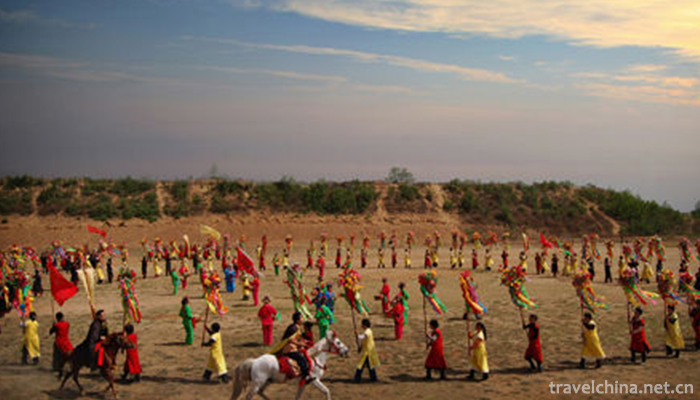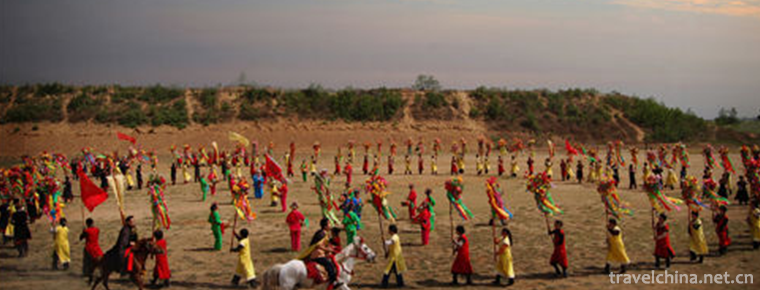Running curtain
Running curtain
Running curtain originated in the Spring and Autumn Period and Warring States Period, formed in the Qin and Han Dynasties, flourished in the Song, Yuan, Ming, Qing Dynasty and the early Republic of China. It is a kind of traditional Chinese folk dance derived from ancient wars. It has a long history, simple formations, varied and profound implications. It contains the concept of "retribution for cause and effect", and reveals the characteristics of changes in celestial phenomena and solar terms. Running curtain is also called curtain among the Chinese people. It has the cultural form of the bottom, the folk and the edge. It covers a large area of northern Henan and southern Hebei. It has always been loved by the masses. It has become an influential and penetrating form of traditional Chinese literary and artistic performances in northern Henan. It has typical characteristics of traditional folk culture and art.
On June 7, 2008, the running curtain was listed in the second batch of national intangible cultural heritage list by the State Council.
symbolic meaning
As a traditional folk culture, the curtain has 24 poles, which symbolizes 24 solar terms a year. Twelve pictures on each curtain symbolize the twelve generic phases of heaven and earth, and 144 embroidery balls on the curtain symbolize the cosmic stars. Another two sides are embroidered with the colorful flags of the Taiji map and the sun, moon and auspicious clouds, called "Caizi", which symbolizes the harmony of yin and Yang between heaven and earth, and the meteorology of all living things.
The young men who hold the lottery are called "lottery heads". In addition, it is equipped with 18 prestigious gongs and drums, trumpets, three-eye guns and so on. When the gong and drum sounded, the horse trumpet blew, and the 24-bar colorful curtain was divided into two teams. Under the guidance of the two colored heads, they walked back and forth in the rhythm of gongs and drums, running like a gallop, looking like a galloping horse in the distance and looking like a mighty battalion in the near future. Whenever a race is over, the gunner fires the gun at once. If the lights are put in the curtain, the evening performance will be very attractive. Dressed in colorful clothes, the young men hold the curtain in their hands, tiger and tiger breeze, two groups of curtain lights pass under the night sky, like fire clouds changing, Jinlong dancing, the scene is very spectacular. Running the curtain is based on the ideal of national peace and peace, and the hope of the people for smooth weather, prosperous grain and prosperous industry.
Historical Evolution
Southern Hebei has a long history of curtain dance. According to the ancient Cizhou Chronicle, "curtain dance is widely spread in southern Hebei, with the Nandayu Village curtain as the most important." Every year, I go to the States and counties to participate in the Spring Festival Flower Festival performance. Legend has it that during the reign of Qianlong in the Qing Dynasty, Nandayu curtain, in a curtain dance in front of the prefecture, ran out of the "Tianyipin" glyph, which was awarded by the state officials. The content of the performance changes with the changes of society and times. The traditional curtain dance begins with the "left and right eye taijitu", such as "one word long river", "Shuanglong outflow", "Xiaotang Wang disorderly point three armies", "four horses in one hall", "five queens and first place", "world peace" and other routines, which are still popular today. On this basis, we continue to push forward the old and bring forth the new. We have created such zigzags as "Dagan Four Modernizations", "Jiuzhou Reunion", "Three Representatives" and "Keeping up with the Times". Every year, we have turned out new patterns to perfect the combination of this ancient traditional folk Flower Festival art form and the spirit of the times, and constantly glow with a new style.
Relevant Legends
Tangyin County "Running Curtain" was born in Gulonghua Society, 15 miles east of the county, with vivid historical legends. It originated in the Spring and Autumn Period and Warring States Period, took shape in Qin and Han Dynasty, flourished in the Song, Yuan, Ming, Qing and early Republic of China. It is a traditional folk art of square derived from ancient wars. It has a long history, simple position, varied and profound implications, implying the concept of "retribution for cause and effect", and revealing the characteristics of changes in celestial phenomena and solar terms. In the folk, "Running Curtain" is also called "Curtain Dance". It has the cultural form of the bottom, the folk and the edge. It covers a large area of northern Henan and southern Hebei. It has always been loved by the broad masses of the people, and has become a traditional form of literary and artistic performances with strong influence and penetration in Northern Henan. It has typical characteristics of folk culture and art.
Stylistic features
Artistic Characteristics
"Running curtain" combines the formation of ancient warfare scene, has its own unique dance steps, formation, props, music. The performance is composed of 48 trunks (or 72 people) and more than 180 assistants, totaling more than 200 people. It is a large square traditional dance performed collectively, and the scene is very spectacular.
Traditional Meaning
"Running curtain" has a profound traditional cultural meaning, each team of 24 people for a "Peng". This refers to the portal made of Pengcao, and the "curtain dance" contains the basic units of the ancient army. Each one 24, 3 and 72 constitute a "curtain dance" group, 72 at the same time coincide with the times.


-
1.Mount Danxia Scenic Area
Danxia Mountain Scenic Area is located in Renhua County, northeast of Shaoguan, Guangdong Province. Danxia Mountain is composed of red sandy scintillate rocks and characterized by red cliffs. Geologis
Time 2018-12-12 -
2.China Aviation Museum
China Aviation Museum is the first large-scale open aviation museum in China. It is located at the foot of Datangshan, Changping District, Beijing. After many years of closure
Time 2018-12-22 -
3.Yangtze River Source of Tuotuo River
Tuotuo River: Located in Tanggula Mountain Town, Southern Region of Golmud City, Qinghai Province, it is the West source of the Yangtze River, south of the Hoh Xili Mountains.
Time 2019-02-22 -
4.Dong Brocade Weaving Techniques
Dong brocade weaving technology, the traditional handicraft of Tongtong Dong Autonomous County in Hunan Province, is one of the national intangible cultural heritage.
Time 2019-04-27 -
5.Construction Techniques of Li Nationalitys Ship type House
The carrier of the excellent architectural skills of the Li nationality will inevitably fade out of sight in the fierce collision between traditional civilization and modern civilization. Today only a
Time 2019-05-12 -
6.Shangdang Laozi
Shangdang Laozi is one of Shanxi local operas. It is a kind of opera popular in southeastern Shanxi. Shangdang Laozi is a tributary of Wu'an Laozi in Hebei Province. During the Daoguang period of the
Time 2019-06-13 -
7.Xiuyan Jade Carving
Xiuyan Jade Carving, one of the national intangible cultural heritage, is a local traditional art in Xiuyan Manchu Autonomous County, Liaoning Province.
Time 2019-07-08 -
8.Beijing Technology and Business University
Beijing University of Industry and Commerce is a multi-disciplinary university in Beijing. It was approved by the Ministry of Education in June 1999 by the merger of Beijing Institute of Light Industr
Time 2019-09-06 -
9.Han Yu
Han Yu (768 - 824 December 25th) retreated. Henan Heyang (now Henan Province Mengzhou People. Claiming to be "Changli," the world is called "Han Changli" and "Mr. Changli"
Time 2019-09-07 -
10.Cheongsam Qipao anecdotes
Helen foster snow is the widow of snow, the author of a journey to the West. This book records his meeting with Mao Zedong in Yan'an cave dwelling period. Helen was only 23 when she first went to Shanghai in 1931. Helen's good friend Polly went all over the United States to
Time 2020-12-11 -
11.Biological resources in Dazhou
There are more than 400 species of vertebrates in Dazhou City, including 60 kinds of mammals, 230 kinds of birds, 14 kinds of reptiles, 10 kinds of amphibians and 85 kinds of fish. There are 52 species of national and provincial key protected wild an
Time 2020-12-20